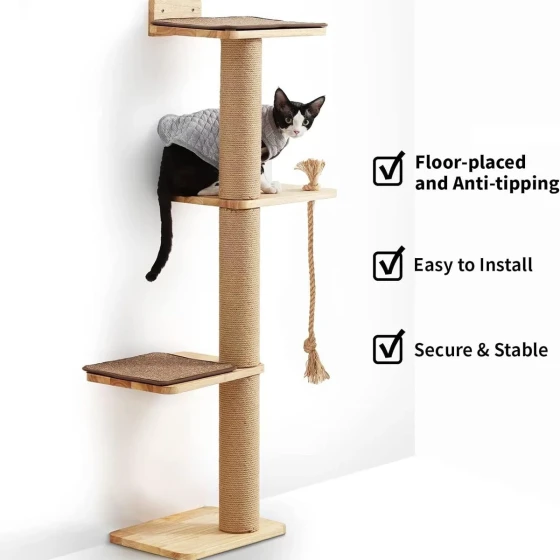How is Cat Epilepsy Caused_Detailed Explanation of Causes and Prevention Methods of Cat Epilepsy
Is your cat having a “seizure”? Don’t panic, this might be epilepsy at work. Cat epilepsy sounds a bit scary, but understanding the causes and how to respond can help you better care for the affected cat, allowing them to enjoy a high-quality life. Cat epilepsy refers to recurrent attacks of brain dysfunction in cats, manifested as sudden, uncontrolled muscle activity, changes in consciousness, or other abnormal behaviors. Although this condition is not as common in cats as in dogs, once it occurs, it poses a challenge for both the cat and the owner.

Cat epilepsy is not a single disease but a neurological symptom caused by various reasons. Simply put, it is like a short circuit or over-discharge of the "electrical activity" in the cat's brain, causing various uncontrolled reactions in the body. Just like the circuit at home occasionally trips, when the brain's "circuit" is disturbed, the cat will have epileptic seizures.
What are the “culprits” behind cat epilepsy?
The causes of cat epilepsy are relatively complex and can be divided into several categories, some are intrinsic problems of the cat, while others are caused by external factors.
1. "Structural problems" inside the brain (structural epilepsy):
This type of epilepsy is often due to lesions in the cat's brain itself, just like physical damage on a circuit board. Common structural causes include:
- Brain tumor: Tumors growing inside the brain can compress or destroy normal brain tissue, causing abnormal discharges.
- Brain inflammation or infection: Inflammation or infection of the brain (encephalitis) caused by bacteria, viruses (such as feline infectious peritonitis virus FIP, feline leukemia virus FeLV), or parasites (like Toxoplasma) may induce seizures.
- Head trauma: Accidents like falls from heights or being hit can cause brain injury, leaving the "root cause" for epilepsy.
- Brain infarction or brain hemorrhage (vascular problems): Similar to strokes in humans, problems in the brain's blood vessels can affect brain function and induce epilepsy.
- Brain developmental abnormalities: Some cats may be born with defective brain structures, increasing epilepsy risk.
2. "Chain reaction" outside the brain (reactive epilepsy):
In this case, the cat’s brain itself is healthy, but problems in other body parts produce harmful substances or signals that affect the brain, causing epilepsy. This is like pollution from a factory affecting the surrounding environment. Common reactive causes include:
- Poisoning: Cats accidentally ingesting toxic substances, such as human drugs, insecticides (especially those containing pyrethroids intended for dogs), certain plants, or even antifreeze (ethylene glycol), can cause toxic epilepsy. Even licking a dog recently treated with flea and tick products can induce poisoning.
- Metabolic diseases: Problems in the body’s "chemical plant," such as liver or kidney disease, hypoglycemia (low blood sugar), hypocalcemia (low blood calcium), hypertension, hyperthyroidism, can disrupt metabolism and brain function, triggering seizures. Especially kittens with a vascular abnormality called portosystemic shunt, whose liver cannot filter toxins properly, are prone to epilepsy.
- Nutritional deficiency: Lack of B vitamins, especially thiamine (vitamin B1), may cause symptoms similar to epilepsy in cats.
3. "Spontaneous epilepsy" with no clear cause (idiopathic epilepsy):
Sometimes, after various examinations, the vet cannot find a definitive cause of the cat’s seizures. This is called spontaneous or primary epilepsy. This condition is less common in cats than dogs and may be related to genetics, though not fully understood yet. Cats with idiopathic epilepsy usually have their first seizure in young adulthood, and diagnosis often requires ruling out other causes. Fortunately, some studies show that cats with idiopathic epilepsy have a higher chance of being seizure-free after treatment compared to dogs.
What are the “signals” of cat epilepsy seizures?
Cat seizures can manifest in various ways and may not always involve dramatic full-body convulsions as one might imagine. Knowing the different types of seizures can help you recognize and respond promptly. Epileptic seizures usually have three stages:
- Prodromal phase (Aura): Minutes to hours before a seizure, cats may show behavioral changes, like dark clouds before a storm. They might become restless, hide, make abnormal sounds (like howling), pace back and forth, or become unusually affectionate and excited. Observant owners may notice these subtle changes.
- Seizure phase (Ictus): The most obvious stage of epilepsy, usually lasting seconds to minutes. Seizure manifestations vary based on the brain area affected:
- Generalized seizures (grand mal): The most recognizable type where the cat suddenly falls, loses consciousness, body stiffens or uncontrollably twitches and paddles, may drool or lose bladder/bowel control, and the head may tilt backward. The whole body is affected.
- Partial seizures (focal seizures): Affect only part of the body, often subtle and easy to miss. For example, twitching of the face, eyelids, or whiskers, ear movement, drooling, chewing in the air (like chewing gum), making strange sounds (like low growling or howling), or abnormal head, neck, or limb movements. Sometimes partial seizures may progress to generalized seizures.
- Complex partial seizures (psychomotor seizures): These cause odd behaviors like chasing the tail, attacking invisible objects, excessive licking or biting body parts, or purposeless running.
- Absence seizures (petit mal): Rare in cats, characterized by brief loss of consciousness where the cat may stare blankly ahead, unresponsive to the environment.
Notably, a special type of cat epilepsy triggered by high-pitched noises is called Feline Audiogenic Reflex Seizures (FARS). Sounds like crinkling aluminum foil, metal spoons hitting ceramic bowls, rustling paper or plastic bags, keyboard or mouse clicks, clinking coins or keys may provoke these seizures, usually involving myoclonic jerks (brief muscle twitches).
- Post-seizure phase (Post-ictal): After the seizure ends, cats enter this phase lasting from a few minutes up to 24-48 hours. They may appear tired, disoriented, unsteady in gait, or show behavioral changes such as unusual excitement or depression, increased appetite, and excessive drinking. Most cats recover to normal quickly.
What should I do if my cat has an epileptic seizure?
Seeing your cat have a seizure will certainly worry you as an owner, but staying calm is very important.
- Stay calm and ensure safety: Don’t panic. First, make sure the cat won’t hurt itself during the seizure. Remove sharp or potentially falling objects nearby to prevent injury during convulsions. If the cat is at a height (like on a table or stairs), catch or surround it with a thick blanket or mattress to prevent falls.
- Do not forcibly restrain or touch: Cats are unconscious during seizures; forcibly pressing or touching them may lead to accidental bites or scratches.
- Record the seizure: If possible, use your phone to record the seizure time, duration, specific signs (generalized or partial convulsions, drooling, incontinence, etc.), and take videos if you can. This information is very helpful for veterinarians.
- Provide a quiet environment: During and after the seizure, try to keep surroundings calm and dimly lit to reduce stimulation.
- Seek veterinary care promptly: Regardless of seizure length, if it is the first seizure, or the seizure lasts more than 5 minutes (status epilepticus, an emergency!), or if seizures occur repeatedly in a short period (cluster seizures), immediately take your cat to the vet, preferably an emergency clinic. Even short seizures deserve prompt examination to determine the cause.
Diagnosing and treating cat epilepsy is like detective work
Diagnosing cat epilepsy requires vets to act like detectives, gradually excluding possibilities.
- Detailed history taking: Vets will carefully inquire about seizure details, including time of the first seizure, frequency, duration, manifestations during seizures, and abnormal behaviors before and after. Your records come in handy here.
- Physical and neurological examination: Vets will perform a complete physical check and neurological assessment, checking reflexes, gait, and signs of other nervous system issues.
- Blood and urine tests: Essential to exclude reactive epilepsy. Checking blood and urine helps assess liver and kidney function, blood sugar, electrolytes, to see if metabolic diseases cause seizures.
- Imaging exams: If structural epilepsy is suspected, vets might recommend X-rays, CT, or MRI scans to view brain structures in detail, look for tumors, inflammation, trauma, etc. MRI usually provides more detailed brain imaging.
- Cerebrospinal fluid analysis: Sometimes, to diagnose brain inflammation or infection, vets collect and analyze the cat's cerebrospinal fluid.
- Other tests: Depending on the case, vets may conduct infectious disease screenings (e.g. FIV, FeLV, Toxoplasma) or specialized examinations.
Once cat epilepsy is diagnosed, treatment depends on the cause.
- Treat underlying causes: If epilepsy is secondary to other diseases (like liver disease or poisoning), first treat the primary disease. Sometimes once the primary disease is resolved, epilepsy disappears.
- Antiepileptic drugs: For spontaneous epilepsy or epilepsy from untreatable structural lesions, long-term antiepileptic medication is usually required to control seizures. These drugs do not "cure" epilepsy but help reduce frequency, duration, and severity. Common drugs include phenobarbital, levetiracetam, etc. Always follow vet instructions strictly; do not stop or change doses on your own to avoid seizure relapse or worsening. Just like patients with hypertension require regular medication, epileptic cats need long-term management.
- Adjust diet and environment: Some cat epilepsy cases relate to diet or environmental stress. Maintaining a regular routine, minimizing stress, and providing balanced nutrition help manage epilepsy.
- Surgery: In very few cases, if epilepsy is caused by brain tumors or other structural disease suitable for surgery, vets may consider surgical treatment.
Preventing cat epilepsy starts with details
Though some causes of epilepsy are uncontrollable (like genetics), we can reduce risks by:
- Avoiding toxins: Safely store medications, cleaners, insecticides, plants, etc. that are toxic to cats to prevent exposure or accidental ingestion.
- Regular check-ups: Take your cat to the vet regularly to detect and treat potential health issues like liver/kidney diseases or hypertension timely.
- Ensure dietary safety: Provide comprehensive and balanced nutrition; do not feed cats human food or medications casually.
- Manage stress: Provide a stable, safe, and comfortable living environment to minimize stressors for your cat.
- Vaccinate timely: Follow vet advice to vaccinate your cat, preventing infectious diseases that might cause epilepsy.
Frequently Asked Questions
- Is cat epilepsy contagious?
Cat epilepsy is not contagious. It is a neurological disorder, not caused by pathogens. - Can cat epilepsy be cured?
It depends on the cause. If epilepsy is due to treatable diseases (e.g. some poisonings or metabolic issues), curing the primary disease may eliminate epilepsy. But for idiopathic epilepsy or epilepsy caused by untreatable structural lesions, there is no cure yet, though seizures can be effectively controlled with medication. - What should I do if my cat has a seizure?
Stay calm, ensure the cat’s environment is safe, avoid forcibly touching or moving, record the seizure details, and seek veterinary care promptly. - If my cat takes antiepileptic drugs, will seizures stop completely?
Even with medication, seizures may still occur. The main goal of drugs is to reduce the frequency, duration, and severity of seizures. Regular vet check-ups are important to adjust medication based on your cat’s condition. - Does cat epilepsy affect lifespan?
It depends on the cause and treatment outcome. Some cats can be well-controlled with medication and live a high-quality life with little impact on lifespan. However, severe brain disease that is poorly controlled may shorten life. Early diagnosis and active treatment are key.
In summary, when facing cat epilepsy, understanding causes, recognizing symptoms, seeking timely medical help, and following vet treatments are crucial to help your cat. Although this process may be challenging, with careful care and professional guidance, most epileptic cats can still enjoy a happy life.





